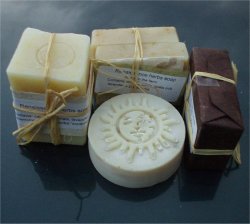
What is Herbal Soap?
Herbal soap is a kind of soap mixed with natural ingredients, juice or extract and vitamins from medicinal plants.
METHOD #1
How to Prepare Herbal Soap:
Utensils:
- Plastic pail
- Wooden ladle or bamboo stick
- Glass or cup
- Mortar and pestle
- Cheese cloth or strainer
- Knife
- Chopping board
- Cooking pot (preferably made of clay, enamel, stainless or glass)
- Stove
- Plastic molders
Akapulko and Guava Soap:
How to Prepare a Decoction:
1. Wash the leaves thoroughly and chop or cut in small pieces.
2. Measure 1 glass of chopped fresh leaves and 2 glasses of water.
3. Let it boil for 15 minutes (start timing when the water starts to boil).
4. After 15 minutes, remove from fire and strain in a cheesecloth. Set aside and let it cool.
Materials:
- 1 glass Caustic Soda (NaOH)
- 3 glasses Akapulko or Guava decoction, cooled
- 5 glasses cooking oil
- coloring powder (optional)
Procedure:
1. Prepare the materials and the utensils needed.
2. Measure 1 glass of caustic soda and 3 glasses of Akapulko or Guava decoction and pour into a plastic pail.
3. Mix well by stirring continuously using a wooden ladle or bamboo stick. Use only one direction in mixing the mixture. Stir until the caustic soda is dissolved.
4. Pour 5 glasses cooking oil into the mixture.
5. Continue stirring until a consistency of a condensed milk is achieved.
6. Pour the soap mixture into desired plastic molders. Set aside and let it cool to harden.
7. After 4-5 hours, remove the soap from the molder.
8. Allow 30 days of ageing before packing. Label the soaps.
Indications:
- Akapulko leaves - anti-fungal
- Guava leaves - antiseptic for wounds
Kamias, Calamansi, Papaya, Cucumber and Radish Soaps:
Materials:
- 1 glass Caustic Soda (NaOH)
- 3 glasses water
- 5 glasses cooking oil
- 1/2 glass juice or extract
Procedure:
1. Prepare the materials and the utensils needed.
2. Measure 1 glass of caustic soda and 3 glasses of water and pour into a plastic pail.
3. Mix well by stirring continuously using a wooden ladle or bamboo stick. Use only one direction in mixing the mixture. Stir until the caustic soda is dissolved.
4. Pour 5 glasses cooking oil into the mixture.
5. Continue stirring until a consistency of a condensed milk is achieved and add 1/2 glass of juice or extract.
6. Pour the soap mixture into desired plastic molders. Set aside and let it cool to harden.
7. After 4-5 hours, remove the soap from the molder.
8. Allow 30 days of ageing before packing. Label the soaps.
Indications:
- Kamias - fruit extract or juice (bleaching soap)
- Calamansi - fruit extract or juice (bleaching soap)
- Cucumber - fruit extract or juice (moisturizer)
- Papaya - extract from fresh leaves (bleaching/moisturizer)
- Radish - extract from the stem (moisturizer)
Reminder:
- Caustic Soda can harm the skin upon contact. Wash immediately with vinegar or anything sour and then wash it with soap and water.
- Caustic Soda is harmful to health and so, make the necessary precaution. Use mask and gloves to protect your body.
source: doh.gov
METHOD #2
You don't need to pay high prices for fancy, scented soaps; you can make your own fragrant concoctions with some simple ingredients and a little know-how.
Steps:
1. Decide what kind of dried herbs you'd like to use. Good choices are lavender for its lovely fragrance, comfrey for its ability to soothe irritated skin, and mint for its invigorating properties. Experiment with your favorite herbs to find your favorite combination.
2. Assemble the other items you will need: the plainest soap you can find (plain glycerine soap is best, but Ivory or another mild, unscented soap will do), a soap mold, and a double boiler.
3. Coat your soap mold with vegetable oil.
4. Heat 1/3 cup water in a double boiler to a simmer.
5. Crumble 3 to 4 tablespoons of herbs into the water.
6. Take the double boiler off the heat and allow the herbs to steep for 15 minutes.
7. Return the pan to the heat and add the bar of soap, cut into small pieces.
8. When the soap is melted, pour the mixture into the soap mold.
9. Leave at room temperature until the soap has hardened (it will be a bit softer than the bar you started with).
10. Open the mold and remove the soap.
source: ehow.com
Training and seminars:
TLRC
Herbal & Bath Soap Making (15 hrs / 2 days) Php 3,399
Please Call Us at 633-6733 or 637-4018 loc 300, 304, 306
5 comments:
Thank you po for sharing. Where can I buy caustic sode in Manila? Email me at livefresh.seafood@gmail.com. Salamat!
are there any local maker of soap mould and imbedded print to soap here in metro manila?
camil073155@yahoo.com
Make your own soap!
How to make soap in the Philippines (eBook)
This ebook contains all the most significant information for soap making in the Philippines.
Contents include:
1. Formulations and soap recipes
2. Supplier lists
3. Types of oils
4. Soap making equipment
5. Safety and troubleshooting measures in soap making
6. Costing and Pricing
7. Packaging Ideas
8. How to start a soapmaking business
and so much more!
Learn how to make soap and build a small business here in Philippines!
For business consultations, please contact bizventures15@gmail.com
http://soapmaking-ebook.blogspot.com/
I have tried that formula which is 1 cup lye ---> 3 cups water---> 5 cups oil, the result? napakatigas po! ang tama ay 1.125 cups of lye ---> 3 cups of water----> and 8 cups of oil.
Sinubukan ko yang recipe nyong iyan na 1 glass caustic soda, 3 glasses of water, and 5 glasses of oil, naku po! matigas at saka walang moisture man lang, tuyot! ang tama ay 1.125 glasses of caustic soda, 3 glasses of water, and 8 glasses of oil. Try it!
Post a Comment